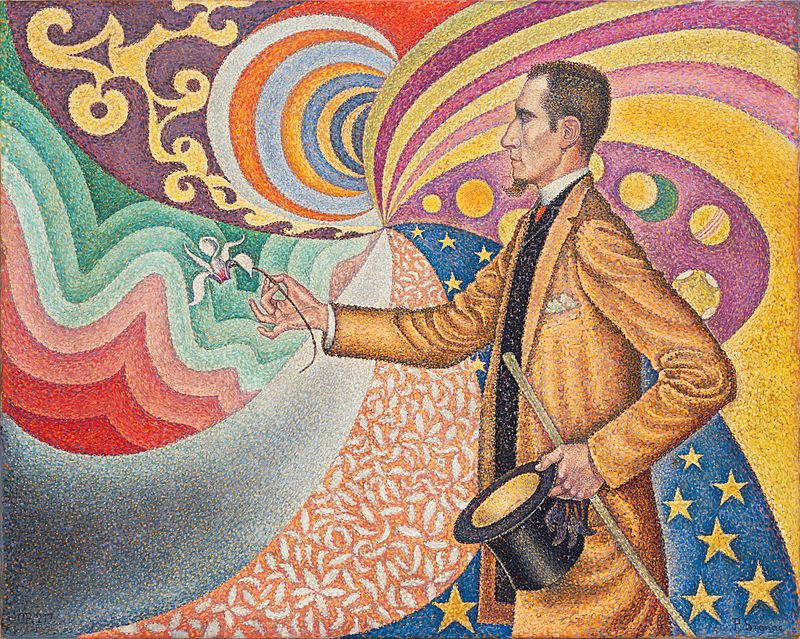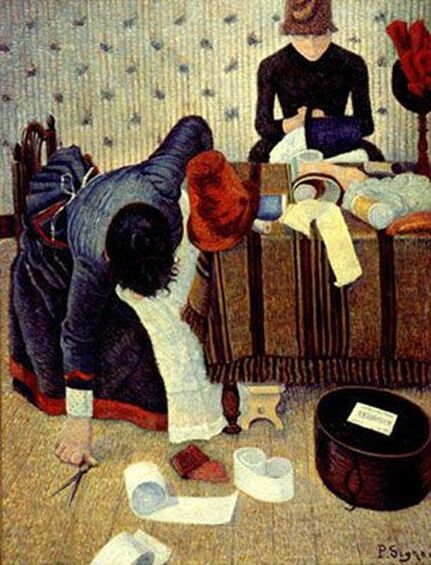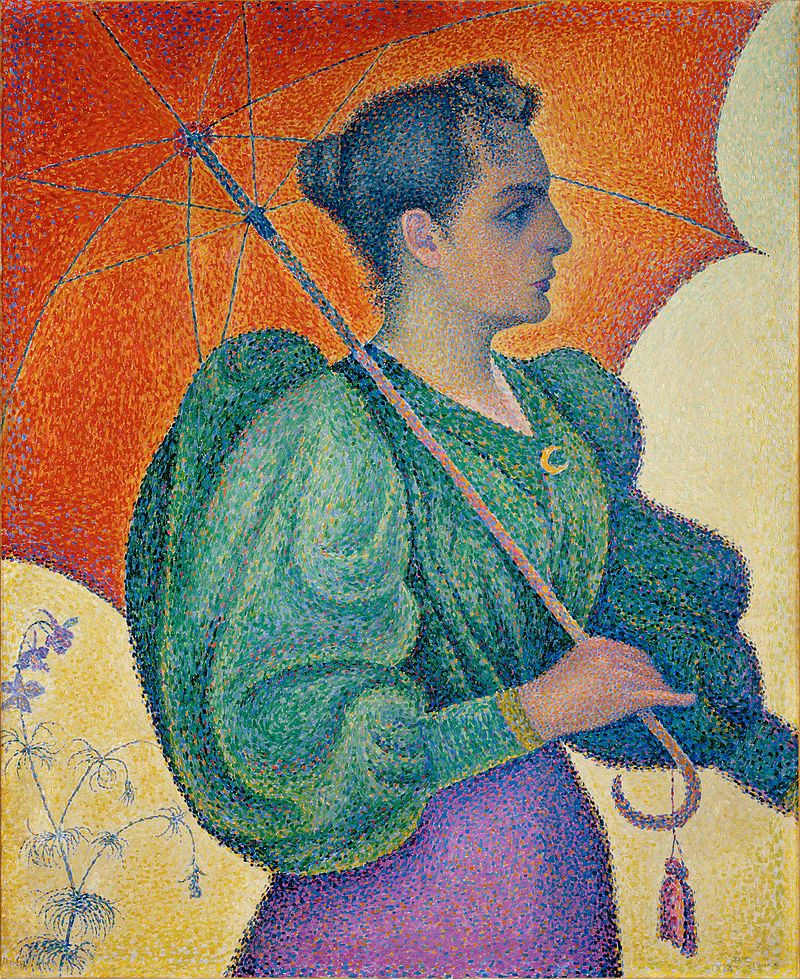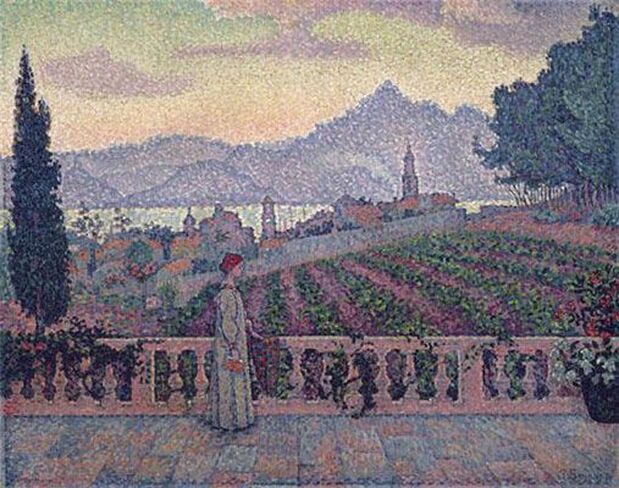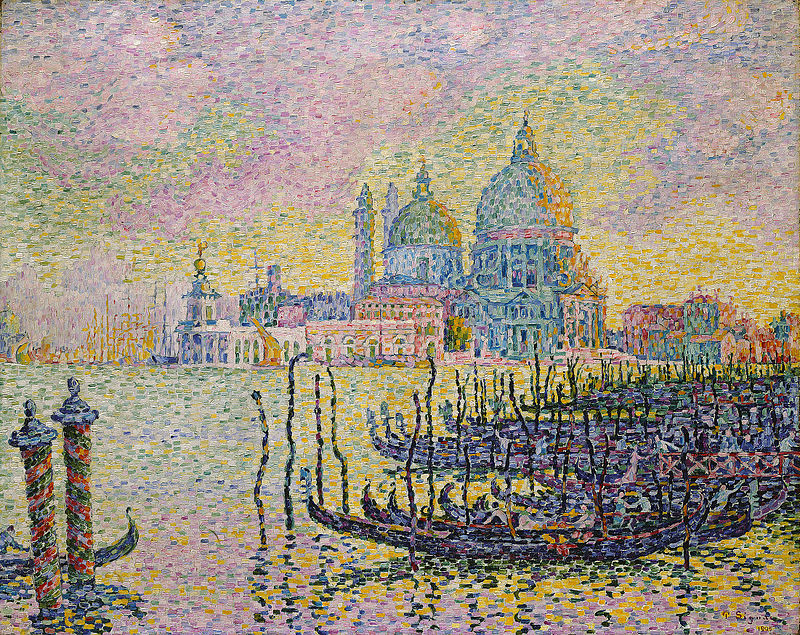AN APPRECIATION: Paul Signac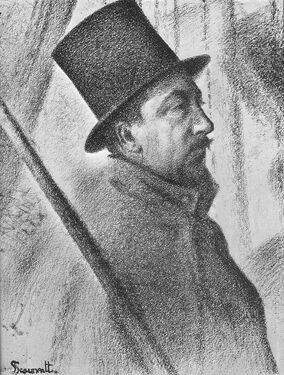 Portrait of Signac by Georges Seurat Portrait of Signac by Georges Seurat
At the Fifth Impressionist Exhibition in 1880, Paul Gauguin spotted a teenager making a sketch of a work by Edgar Degas. Outraged, Gauguin went over to the boy and said: “One does not copy here, sir." He then threw the would-be artist out of the exhibition. Little did Gauguin know that at the Eighty Impressionist Exhibition six years later, Paul Signac's works would be hanging along side Gauguin's. Furthermore, they would be the talk of the exhibition.
Signac was born in Paris in 1863. Even though his family was middle class, they were quite liberal and moved to the Montmartre section early in Paul's life. There he was exposed to writers, artists and intellectuals. His parents also encouraged him to go to avant garde art exhibitions. By this time, the Impressionists and their circle had become popular and they became some of Signac's heroes. A one-man exhibition by Claude Monet at the offices of the magazine “La Vie moderne” in 1880 particularly impressed Signac and convinced him to follow a career as an artist. Signac was largely self-taught. He did some study of architecture and received a few lessons from the painter Emile Bin. However, most of what he learned came from studying and copying works by the Impressionists and other avant garde artists. Naturally, Signac's early style was based on Impressionism, particularly the work of Monet and Gustave Caillebotte. His interest in Impressionism was encouraged by Armund Guillaumin who Signac met in 1884 and subsequently by Impressionist legend Camille Pissarro. Disillusioned with the Paris Salon, the annual government-sponsored art exhibition, Signac helped to found the Societe des Artites Independent in 1884. Unlike the Paris Salon, the Societe's exhibition, the Salon des Independents, would have no entry juries and would award no prizes. This would give artists more freedom to exhibit their work and would leave judgment of the works to the viewers. The Salon des Independents would become an important forum for modern art over the ensuing decades. Through the Salon des Independents, Signac met Georges Seurat. The two artists became good friends. Signac encouraged Seurat to use a brighter, more Impressionistic, palette. Seurat told Signac about his interest in color and optics. Together they set out to develop a new artistic style based on the application of scientific principles. The new style was to become known as “Pointillism” or “Divisionism.” It involved creating images by placing small dots of color next to each other. When the viewer stands back a few feet from the painting, the dots blend in the eye to form other colors. This approach produced more vibrant colors than mixing colors on the palette. It soon attracted converts. Indeed, when it was demonstrated to Pissarro, he abandoned (temporarily) the Impressionist style he had helped to create and began working as a Pointillist. In addition, he insisted that Signac and Seurat be included in the Eighth Impressionist Exhibition. Degas and Eugene Manet, possibly speaking for his wife Berthe Morisot, objected. Monet declined to participate. However, Seurat and Signac's works drew the most attention at the exhibition. Seurat and Signac were now leaders of their own movement, which was dubbed “Neo-Impressionism.” The introverted Seurat acted as the visionary while the more extroverted Signac acted as a prophet spreading the word. Indeed, Signac even taught his friend Vincent Van Gogh how to do Pointillism. As time went on, Seurat's work became more stylized to the disappointment of Signac who feared that Seurat was abandoning the style they had developed. Still, when Seurat suddenly died in 1891, Signac was devastated. Nonetheless, Signac carried on championing Neo-Impressionism. This included writing a Neo-Impressionist manifesto “From Delacroix to Neo-Impressionism” in 1899. While Signac carried on working in the Pointillist style, his brush work became looser over time and more expressive. He also became increasingly interested in watercolors. In 1893, Signac produced one of his few portraits. “Woman With An Umbrella” was a painting of his wife Berthe Robles, a cousin of Pissarro, who Signac had married the year before. For the most part, Signac concentrated on landscapes. An avid sailor, his subjects were often scenes of the sea and the coast. Signac purchased a villa in St. Tropez in 1897. He had a massive studio constructed within the house. There, he would produce large Pointillist canvases based upon studies he had made during his various voyages on his boat. Although a financially successful artist, Signac's political views, like those of Pissarro, were quite left wing. He even became interested in anarchism. In addition to visual art, Signac wrote both fiction and non-fiction. In 1912, Signac left his wife and took up living with his former student, the painter Jeanne Selmersheim-Desgrange. Together, they had a daughter. During World War I, Signac became disillusioned with art and produced very few paintings. He output increased after the war but this was primarily due to a need to raise money to support his family. Signac died in 1935 of septicemia. See our profiles of these other Post Impressionists
Emile Bernard Paul Cezanne Paul Gauguin Henri Toulouse Lautrec Odlion Redon Henri Rousseau George Seurat Vincent Van Gogh See our profiles of these Impressionist artists and members of their circle.
Frederic Bazille Eugene Boudin Marie Bracquemond Gustave Caillebotte Mary Cassatt Paul Cezanne Edgar Degas Henri Fantin-Latour Eva Gonzales Paul Gauguin Armand Guillaumin Edouard Manet Claude Monet Berthe Morisot Camille Pissarro Pierre Auguste Renoir Alfred Sisley Suzanne Valadon Victor Vignon |
Above: Signac's "Opus 21", a portrait of Felix Feneon.
Above: "The Milliners" is one of the first works exhibited by Signac.
Below: Signac's wife Berthe Robles appeared in "Woman With An Umbrella." Signac was primarily a landscape painter and was an avid sailor. As a result, many of his pictures are of where the land meets the sea.
Above: "Lady On A Terrace." Below: "Grand Canal, Venice." |
Artist appreciation - Paul Signac
